
Issue 075
May 2011
What actually happens when Demian Maia slams on a reverse triangle from the top, or Nick Diaz magics up a gogoplata? FO presents the science behind submissions
Renowned grappling coach and former Shooto light heavyweight champion, Erik Paulson once famously said that “the human body is a submission waiting to happen.” Given what we discovered researching the human biology behind submission wrestling, we’re inclined to agree. With the average adult body made up of over 1300 ligaments and tendons, 12 major muscle groups comprising of approximately 640 skeletal muscles, 206 individual bones, and two major carotid arteries that are the brain’s lifeline, we’re all a proverbial playground of locks, chokes and crushes...
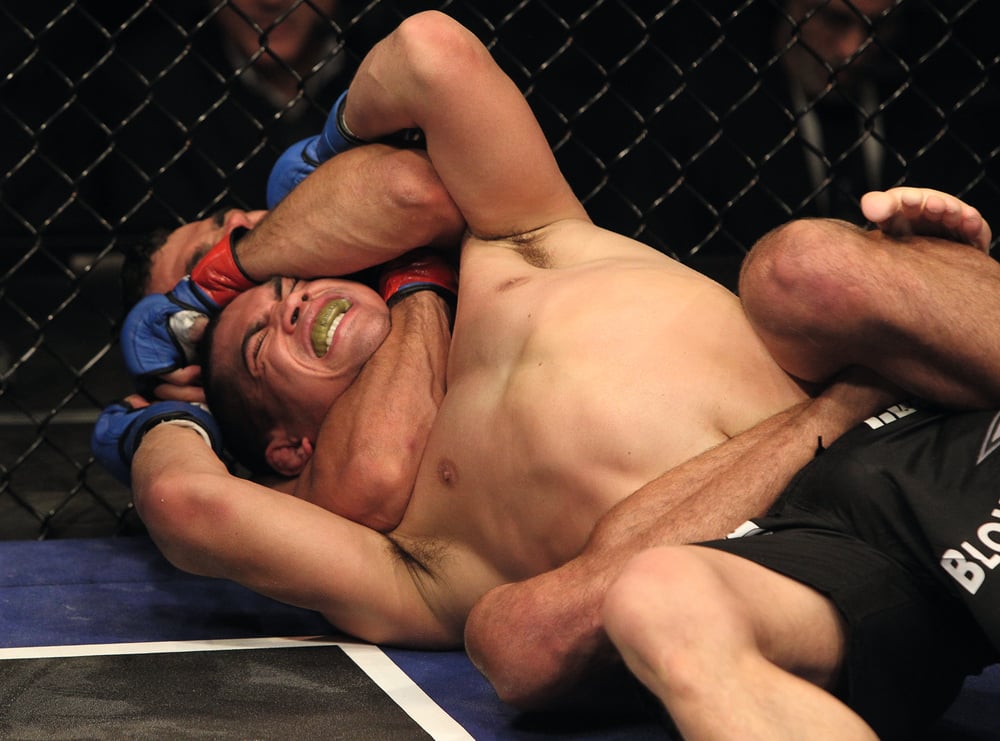
The Rear Naked Choke
One of the most primal and visually dramatic of all the submissions investigated here, the rear naked choke is as synonymous with mixed martial arts as any highlight-reel head kick. No submission has enjoyed greater success inside the Octagon than the ‘RNC‘, and for good reason. It requires only 5lb of force to render someone unconscious with an RNC. That’s less than the amount required to crush an egg, and the average lightweight alone can produce over 30 times that. Once applied, the end results can be as quick as they are emphatic.
The human body is entirely dependent upon the brain’s ability to function, and Woody Allen’s ‘second favorite organ’ requires 20% of our total oxygen supply. The RNC cuts off that supply, not by blocking the windpipe taking air into the lungs, but by stemming the flow of the carotid arteries that take oxygenated blood from the lungs to the brain. This ‘blood choke’ is often quick and can be comparatively painless, explaining why many fighters are ‘choked unconscious’ in a short space of time without tapping.
With an RNC ‘slapped on’, the brain goes into immediate survival mode. Within seconds vision becomes blurred and speech impaired as vital organs begin to shutdown. The heart-rate drops by almost 40% and respiratory rate even further, by 55%. All the while 8.2 billion neurons located in the brain’s frontal cortex come to a standstill. With that goes the brain’s short-term memory capacity, which is why vanquished fighters seem to be asking ‘what happened?’ as they’re roused from unconsciousness.
In controlled circumstances it might be conceivable for a fighter to take as many as eight to tenseconds attempting to break the choke before his lights go out. Factor in the huge physical demands and exertion of a three or five-round fight, however, and that number halves and halves again as the brain and body beg in tandem for oxygen. 95% of all UFC fighters caught in a game-ending RNC elected to tap rather than black out.
Technical Difficulty: 2/5 Pain Rating: 2/5
Notable examples: Royce Gracie vs Gerard Gordeau at UFC 1. Matt
Hughes’ brace over Frank Trigg at UFC 45 and 52
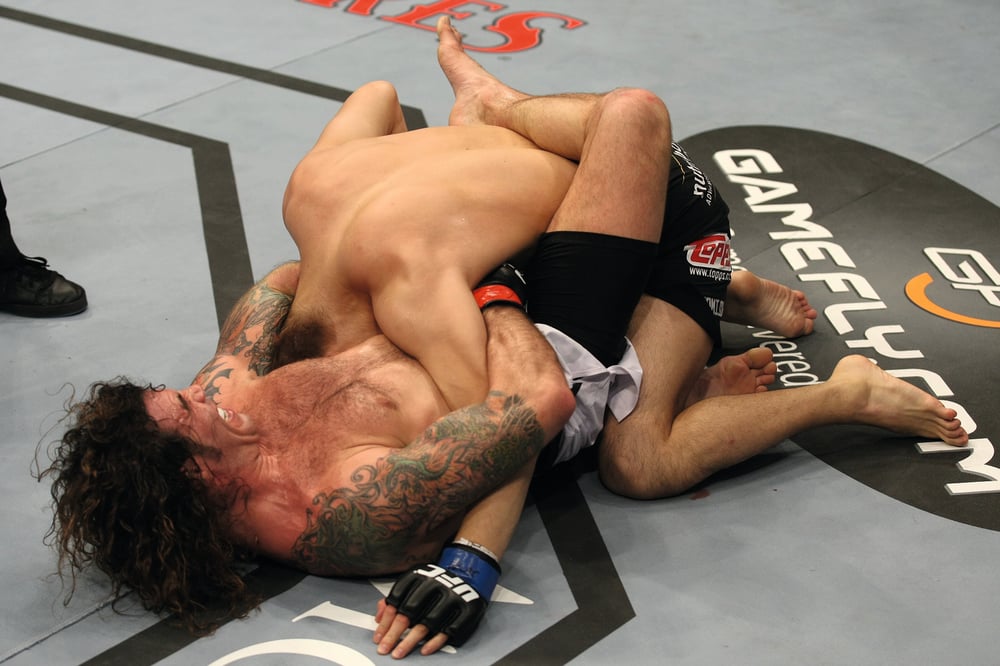
The GUILLOTINE
Considering the guillotine is one of the most notorious execution devices in modern history, it’s no surprise that its namesake is so feared and decisive inside the cage. Performed standing, from guard, or, in some creative instances from the mount, the guillotine can be executed as a choke on the windpipe, a crank on the neck, or a combination of both.
The undoing of many an inexperienced wrestler prone to ‘shooting high’, the guillotine’s mechanics are relatively straightforward. Using the arms to encircle an opponent’s neck in a tight circular grip, pressure is then applied by squeezing the bicep, thereby cutting off one, or both, of the major carotid arteries in the same vain as the rear naked choke in what is commonly referred to as a ‘blood choke.’ Once secured the end result is invariably one of tap or nap.
What makes the guillotine particularly devastating, however, is when the head is pulled down or ‘cranked.’ The result is hyperflexion of the neck – the movement of a joint beyond its normal range – putting severe strain on the muscles, tendons and ligaments of the spinal column. This can shock the victim into hurriedly tapping and provide a pay check for his chiropractor. Unlike the rear-naked choke, though, it is leverage, and not pure arm strength that is the key to exerting maximum pressure and, ultimately, the tap.
Technical Difficulty: 2/5 Pain Rating: 2/5 (choke) 3/5 (crank)
Notable examples: Antonio Nogueira vs Tim Sylvia at UFC 81.
Dan Miller vs Dave Phillips at IFL 2007 – ‘The tightest guillotine
I’ve ever seen’ – Bas Rutten
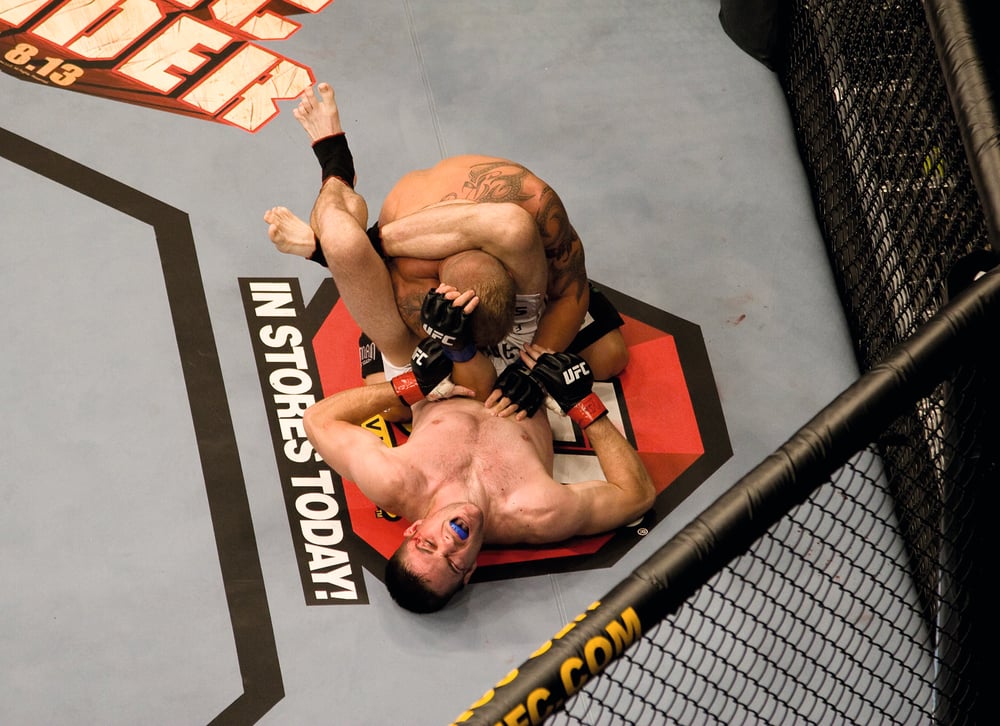
The TRIANGLE
Most commonly being applied by a fighter on his back, the triangle is an extremely successful counter submission. The key to the choke’s success is the phenomenal power that leg muscles can apply. The inner thigh is made up of five separate muscles (the upper arm has just two) and benefits from core stabilization provided by attachment to the pubic bone. Adding to an opponent’s woe, the triangle usually incorporates the victim’s own arm to create even more pressure within the ‘triangle’ itself. So it can be combined with an armbar.
“I think it has a good success rate because once it’s locked in, it is hard to defend against” says UFC lightweight sensation Paul Sass, who boasts eight victories via his adapted triangle choke known as ‘The Sassangle’. “It’s probably the hardest submission to escape from and one that you can mostly set-up from anywhere.” And if evidence were ever needed as to just how potent a weapon the triangle is, Mike Guymon’s loss to DeMarques Johnson in January saw the 36 year-old verbally tap to a body-triangle that left him with damaged ribs and two ruptured vertebrae.
Technical Difficulty: 3/5 Pain Rating: 3/5
Notable examples: Anderson Silva vs Chael Sonnen at UFC 117. Toby
Imada vs Jorge Masvidal at Bellator 5 for the 2009 Fighters Only World
MMA Awards ‘Submission of the Year’
The GOGOPLATA
Chokes in general are comparatively less painful than their lock or muscle-crush counterparts. Their objective is usually to bring about unconsciousness rather than discomfort. Not so the gogoplata.
A sophisticated choke that involves a great deal of imagination and even greater flexibility, it is typically set up from the rubber guard and involves bringing a leg over and under an opponent’s head. From there, unlike the triangle choke which uses the thighs to clamp shut the carotid arteries to the sides of the neck, the gogoplata involves pressing the shin against the throat. The opponent’s head is then pulled down using either a hand or, for even greater force, the opposite leg. Whilst technically an ‘air-choke’ due to the compression of the wind-pipe by the shin bone, it’s commonly the pain of the shin pressed into the throat that brings about a tap: the front of the neck lacks the muscular protection afforded to the sides and back.
Technical Difficulty: 4/5 Pain Rating: 4/5 (5/5 if your
Adam’s apple’s an ‘outtie’ – we kid you not)
Notable examples: Shinya Aoki vs Joachim Hansen and Katsuhiko Nagata
at Pride Shockwave 2006 and Dream 4 respectively. Nick Diaz vs
Takanori Gomi at Pride 33
The MUSCLE CRUSH
The gogoplata may score bonus points when it comes to exotic naming conventions, but muscle-crushes do exactly what they say on their tins. Largely overlooked in favor of a transition to an arm or kneebar, muscle crushes are the liver kicks of the grappling domain: great fun to land and a world of hurt on the receiving end.
Part of the collective ‘compression lock’ family, the ominously named ‘bicep and calf slicers’ are the most notorious. Executed by bending an opponent’s limb over that of the attacker, the bicep or calf muscles are forcibly crushed back against the bone, which serves to act as an anvil. An uncomfortable and uncompromising lock, the muscle-crush is made all the more painful when applied against a particularly bony part of the body, such as the shin.
Whilst they may be something of a rarity within MMA, only the brave, or foolish, will struggle against a muscle crush. The potential damage ranges from internal hemorrhaging; to severe and acute inflammation; and, in extreme cases, deep-tissue bleeding which can ultimately lead to myosotis ossifican – a painful condition where bone grows within the muscle tissue.
Technical Difficulty: 3/5 Pain Rating: 5/5
Notable examples: Ivan Menjivar vs Joe Lauzon at Apex:
Undisputed. Ovince St Preux vs Ombey Mobley at XFC 8
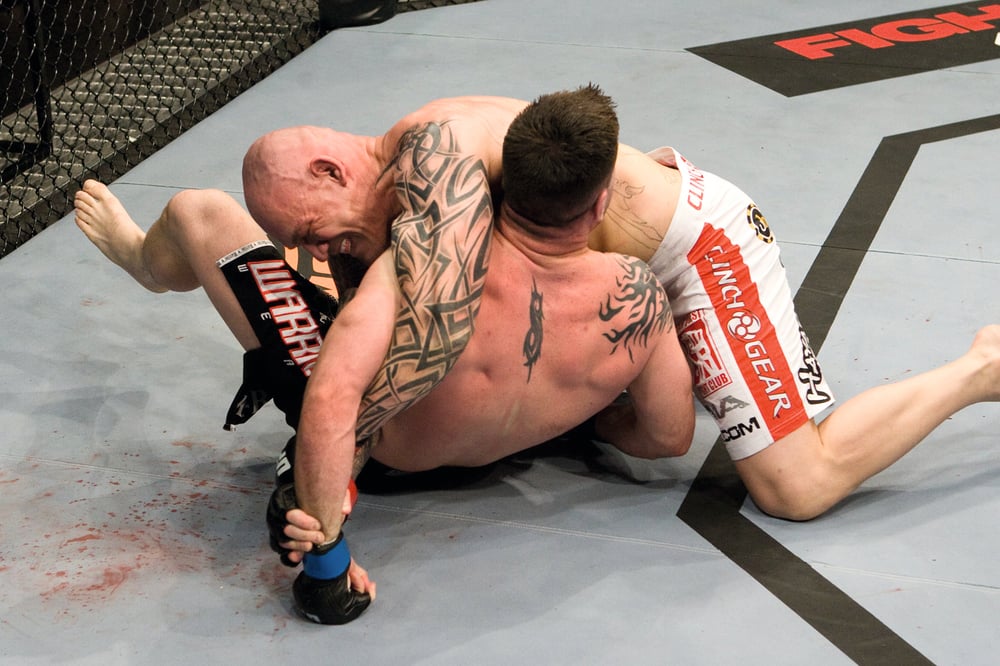
The KIMURA
At first glance a kimura may appear as if it is putting pressure on the elbow joint. And, to an extent, it is. But the real objective of the kimura is to attack the shoulder.
Classed as a ‘ball and socket’ joint – one that enables a 360° rotation – the shoulder sacrifices the structural stability of a hinge joint, such as the knee, for superior mobility. Relying upon the muscles and tendons that make up the rotator cuff to maintain its structural integrity, it is these muscles that are stretched by the kimura as the arm and shoulder are rotated inwards.
A kimura hold creates a powerful burning sensation in the shoulder as the cavity located between the top of the upper arm bone and below the collar bone shrinks. In many instances the tendons of the rotator cuff themselves become irritated and inflamed causing a condition known as impingement. A familiar feeling to any grappler that has ever been partnered in training with the over-zealous ‘new guy’ – all caveman strength and 250lb stone of him.
What makes the Kimura especially successful is that pressure is applied to the shoulder’s passive structures, notably the three major ligaments, the soft-tissue that encircles the shoulder joint, and the cartilage that sits between the upper arm and shoulder socket.
Equal parts brute force and technique, escape from a Kimura is not uncommon – as evidenced by Dan Hardy’s stoic refusal to tap to GSP at UFC 111 – but when applied quickly, or with considerable strength, they are a deadly addition to a fighter’s submission arsenal.
Technical Difficulty: 3/5 Pain Rating: 4/5
Notable examples: Fedor Emelianenko vs
Kevin Randleman at Pride 2004. Krzysztof
Soszynski vs Brian Stann at UFC 97
The HEEL HOOK
If muscle crushes are the liver kicks of the grappling world, then heel hooks are the stray kicks to the groin that bring tears to the eyes of fighter and fan alike. They’re largely banned in competition Brazilian jiu-jitsu, Russian sambo, and at The Ultimate Fighter open trials. Heel hooks are notoriously painful given the structural weakness of the ankle that verges on small-joint manipulation – techniques illegal under the Unified Rules of Mixed Martial Arts – and the acute twisting of knee ligaments that are responsible for a high number of injuries.
Performed off the mat having secured an opponent’s leg, the ankle is typically grasped with either internal (towards an opponent’s body) or external (away from an opponent’s body) rotation applied. As well as significant force applied to the ankle joint itself, it is the unnatural and extreme rotation applied to the knee ligaments that produces a pain that has to be felt to be believed.
Usually performed quickly, and with minimal set-up, heel hooks are as effective as they are dangerous. “With a triangle you are going to sleep, with a heel hook you are going to snap your knee and ankle and won’t be able to walk for six weeks,” says Paul Sass who has two heel hook wins to his name. “If I was on the receiving end, I would choose a triangle choke any day.”
Technical Difficulty: 3/5 Pain Rating: 5/5
Notable examples: Any one of heel hook connoisseur Rousamir
Palhares’ four. And perhaps the most famous of them all, Ryo Chonan’s
flying scissor heel hook victory over Anderson Silva at Pride Shockwave
2004 (the last legitimate loss of ‘The Spider’s’ career)
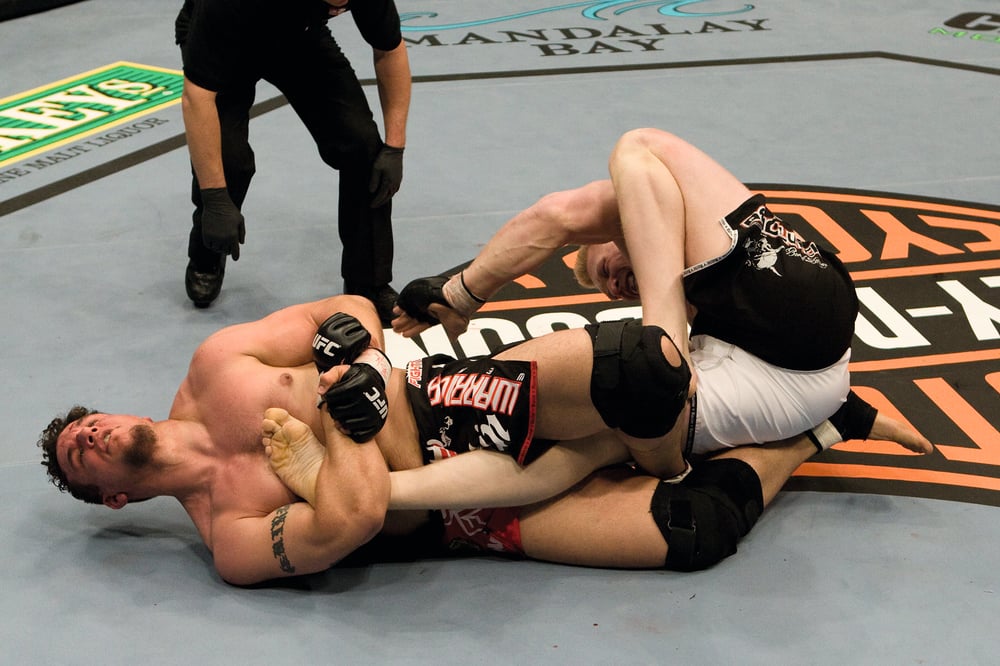
The KNEEBAR
When God drew up his blueprints for the human knee he created not only the body’s largest joint, but one of its most complex. Designed to support nearly the whole weight of the body, yet provide a comprehensive range of motion, the knee is both a work of anatomical artistry and one of its most vulnerable components due to its limited range of upward motion. It’s a perfect target for fighters inside the cage.
Using the upper thigh as a fulcrum against which to lever an opponent’s leg, the aggressor simultaneously raises his pelvis whilst pulling down on the opponent’s heel and shin. This causes the knee to hyperextend at the joint way past past its natural straightened position.
With three of the knee’s four major ligaments, notably the fabled anterior cruciate ligament (‘ACL’), subjected to unnatural extension, the pain is sudden and excruciating. The knee has no other place to go than ‘pop’ with it requiring less than 10% extension to put the ligaments under severe duress.
Applied to its fullest for any length of time, the risk of bone bruising, cartilage damage and, more seriously, tears or detachments of the ligaments themselves are a very real threat. Kneebars are potential career enders.
Technical Difficulty: 4/5 Pain Rating: 4/5
Notable examples: Frank Mir vs Brock Lesnar at UFC 81.
Roger Huerta vs Chad Hinton Bellator FC 13
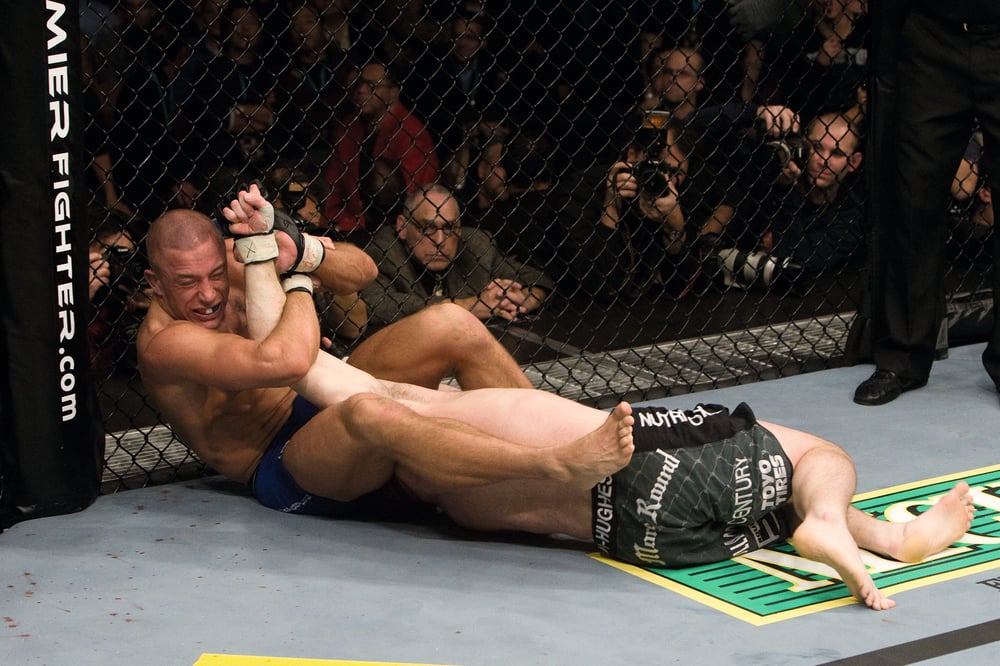
The ARMBAR
Much like its lower-limbed cousin the kneebar, the objective of the armbar is to cause hyperextension of a joint, in this case the elbow, by trapping the arm in a fulcrum and pulling down with considerable force.
If you hold your arm out straight it doesn’t take a scientist to realize it will only bend one way at the elbow. Try bending it against the grain and that twinge of discomfort you feel running up from the elbow to the shoulder is your radial and ulna ligaments, and brachialis muscle, being stretched beyond their natural range.
Now imagine you’ve got a 205lb-plus BJJ black belt tugging away on it with the sole intention of it taking home as a souvenir and it’s easy to see why the armbar is one of the most successful submissions in MMA history. Not to mention one that lends itself to a certain amount of creativity and flamboyancy with ‘flying’ armbars some of the most spectacular and dramatic submissions ever witnessed.
Technical Difficulty: 3/5 (standard) 5/5 (flying) Pain Rating: 3/5
Notable examples: Dustin Hazelett vs Josh Burkman at the TUF 7
Finale. Rumina Sato’s ‘seen to be believed’ flying armbar victory in just
six seconds of the first round over Charles Taylor at Shooto: Devillock Fighters
The TWISTER
Something of an enigma that is best described as a ‘simultaneous sideways body bend and neck crank,’ the ‘twister’ is probably as rare a submission inside the cage as there is. With origins in wrestling, it has most notably been advocated and popularized within the MMA community by 10th planet jiu-jitsu founder and no-gi guru Eddie Bravo.
Predominantly executed from side control or back mount, the set-up involves securing a hook through an opponent’s leg and around the ankle whilst also securing both hands together around the neck – thereby isolating an opponent’s opposing leg and arm. Having secured the limbs and established control over the body, the head is then pulled back towards the trapped shoulder causing hyper-flexion of the cervical spine. In addition to the spine, tremendous pressure is also applied to the knees, torso and, in particular, the abdomen as the unfortunate victim resembles a contorted rag doll.
As rare on the mat as a James Toney double-leg takedown, it is a complex submission of near mythical properties that, when it does arrive, is well worth the wait.
Technical Difficulty: 5/5 Pain Rating: 4/5
Notable examples: Gerald Strebendt is widely accredited with the first successful twister in MMA with a 2004 win over Dave Elliot at CWFC7, whilst female bantamweight star Shayna Baszler has two to her name
Submissions Rich List
The UFC has been rewarding its fighters with ‘Submission of the Night’ bonuses since as far back as UFC 70: Nations Collide with 56 fighters sharing a generous $3,855,000 between them.
To date, Tom Lawlor remains the recipient of the single largest bonus payout: $100,000 at for his 55-second guillotine of CB Dolloway at UFC 100: Making History, where all bonuses were $100,000. But even a 100-large doesn’t get a fighter onto today’s UFC’s ‘Submission Rich List’...
Demian Maia
With four ‘Submission of the Nights’, including three in a row following his UFC debut in October 2007, the promotion’s pinnacle BJJ player tops the Submissions Rich List with $215,000 in bonus cheques… and counting.
Cole Miller
Scoring his first submission bonus in 2008, back-to-back honors over Dan Lauzon and Ross Pearson in 2010 have propelled the American Top Team member to second spot with $150,000 in bonuses.
Terry Etim
A guillotine choke victory over Matt Grice at UFC 70 saw the 14-3 lightweight become the recipient of the first official ‘Submission of the Night’ honor. Two more since have amassed the talented Englishman a tidy $130,000 in total.
Honorable mentions: Anderson Silva (two bonuses) – $120,000,
Clay Guida (again, two) – $110,000
‘Snap. Crackle. Pop’
MMA’s most uncomfortably viewed submissions
Frank Mir vs Tim Sylvia UFC 48: Payback
With a ground game as slick as sandpaper, Tim Sylvia’s ill-judged decision to follow BJJ wizard Frank Mir to the ground in their 2004 heavyweight title fight saw the ‘Maine-iac’ swiftly caught in an armbar that left him with a broken arm, a titanium plate, and a six-month layoff for his troubles.
Sakuraba vs RENZO Gracie Pride 10
In one of Pride’s most revered contests, Japanese hero Kazushi ‘The Gracie Hunter’ Sakuraba continued his scourge over BJJ’s first family by breaking Renzo’s arm via a kimura. With family and national pride at stake, however, Renzo refused to tap, with only the referee calling a stop to proceedings.
Shinya Aoki vs Mizuto Hirota
Dynamite 2009!
Breaking an arm may be an occupational hazard of a professional fighter, but having your vanquisher then flip you the finger immediately afterwards is just bad manners. Which is exactly what Dream lightweight champion Aoki did following his hammerlock victory over Hirota. Former cop Aoki was less than remorseful afterwards: “I heard it break, and I thought, ‘Ah, there, I just broke it.’ I was stopped afterward, but even if I hadn’t, continuing to break it more would have been fine by me.”










